


Future of policing report

Sponsored by
An Garda Síochána
Ireland’s NaƼonal Police and Security Service






Sponsored by
Ireland’s NaƼonal Police and Security Service


Having joined An Garda Síochána as Assistant Commissioner for Roads Policing and Community Engagement in May 2020 – at the height of the Covid-19 pandemic –Hilman reflects on how “easy it is to forget our many achievements in that difficult context”.
However, Hilman’s remit is much broader than roads policing, and she has responsibility for the Garda National Community Engagement Bureau; the Garda Youth Diversion Bureau; and the Garda National Public Order Unit; as well as leading on the roll out of the Community Access Support Team, or CAST project, in Limerick and on the national roll-out of the local community safety partnerships.
Equipped with 40 years of policing experience, in late 2024, the north Belfast native also assumed responsibility as Assistant Commissioner for the Eastern Region which incorporates counties Waterford, Kilkenny, Carlow, Laois, Offaly, Kildare, Meath, and Westmeath.
‘Reversing the trend in road deaths’
Amid an unwelcome upward trend in deaths and serious injuries on Ireland’s roads, Assistant Commissioner for Roads Policing and Community Engagement Paula Hilman meets with Ciarán Galway at An Garda Síochána’s (AGS) Phoenix Park headquarters to provide an update on roads policing efforts to reverse this.
Reflecting on the broader evolution of policing in the State over the last five years, the Assistant Commissioner emphasises the continued implementation of the new Garda Operating Model which will see the organisation’s divisions reduced from 28 to 21 as per A Policing Service For Our Future
Across each of her portfolios, Hilman explains that her work is primarily driven by a commitment to enabling frontline gardaí.
“In my Garda Headquarters role, the predominant challenge has been assisting individual members on the frontline at 3am. What equipment do they need? What training do they require? What information do they need? If we focus on answering these questions, then our members can continue to effectively and efficiently protect the public.”
Specifically, in roads policing, An Garda Síochána has deployed new technology – including via the Garda
Active Mobility Project – “to enable our members to have ready roadside access to Garda PULSE system and data conducive to making our roads safer”.
A total of approximately 11,800 mobility devices have been rolled out to operational gardaí. Using the Traffic App, a uniformed Garda member can scan car registration plates and instantly access information relating to tax, insurance, NCT, and any police warnings relating to a vehicle.
Simultaneously, since November 2023, the Motor Insurers Bureau of Ireland (MIBI) has been providing An Garda Síochána with motor insurance information, meaning that the insurance databased within the Traffic App is updated every 24 hours. This information – relating to insurance policy details –has led to a substantial increase in detection of uninsured drivers and vehicle detentions.
“Acquiring access to insurance data has been a gamechanger for An Garda Síochána,” Hilman comments, adding: “This is an ongoing project in collaboration with the MIBI, and each month we detect an average of 2,200 people driving without insurance and we seize 1,600 cars.
“Simultaneously, we are working with the Department of Transport to determine how we can increase the information we can access in relation to the National Vehicle and Driver File (NVDF) database. This would enable frontline gardaí to quickly identify road users who are recidivist offenders.”
Within AGS, the Garda National Roads Policing Bureau (GNRPB) is primarily responsible for roads policing policy development and closely liaises with the Department of Transport, providing information to inform new legislation, and preparing the broader organisation to respond to legislative changes relating to roads policing.
A recent example is the preparation undertaken to respond to the implementation of the Speed Limit Review Group’s final report in February 2025. Published in September 2023, the report recommended that:
• the default speed limit on national secondary roads be reduced from 100km/h to 80km/h;

“An Garda Síochána’s focus –and mine as Assistant Commissioner with responsibility for roads policing – is to work collaboratively to reverse the current trend.”
• the default speed limit for the local and rural roads network be reduced from 80km/h to 60km/h; and
• the default speed limit on urban roads, including built up areas alongside housing estates and town centres, be reduced to 30km/h.
“Overall, at national level, the GNRPB works in partnership with key road safety stakeholders, such as the Department of Transport, and the Department of Justice, the Road Safety Authority, Transport Infrastructure Ireland, and the National Transport Authority, among others,” the Assistant Commissioner explains.
Meanwhile, each of the 21 Garda division has its own Roads Policing Unit reporting to a divisional officer at Chief Superintendent level, while a direct link to the Assistant Commissioner at Garda Headquarters exists via the four regional Assistant Commissioners.
“The GNRPB also has meetings with the roads policing Inspectors,” Hilman explains, “while I, as Assistant Commissioner, liaise with representatives from the divisions at Chief Superintendent level. As such, we have significant internal collaboration.
“This link drives performance while acting as a conduit for feedback between roads policing gardaí and the divisions regarding the equipment and the training they need to do their job.”
Across each of the stakeholders involved in road safety, the predominant priority now is the post-Covid trend towards increased road deaths. While in 2021 road deaths had decreased to 130, this figure increased the two consecutive years that followed (155 in 2022 and 184 in 2023). While 2024 recorded 10 fewer road deaths than the previous 2023, the figure of 174 is still greater than the total figures of eight of the last 10 years.
“While we had recorded a significant downward trend in road deaths during the Covid pandemic, but now we have observed a significant increase,” Hilman acknowledges.
Among the chief contributors to road deaths, An Garda Síochána designates four as ‘lifesaver offences’. These are:
1. failing to wear a seatbelt;
2. driving under the influence of alcohol or drugs;
3. using a mobile phone; and
4. speeding.
“In this context, An Garda Síochána’s focus – and mine as Assistant Commissioner with responsibility for roads policing – is to work collaboratively to reverse the current trend,” the Assistant Commissioner affirms.
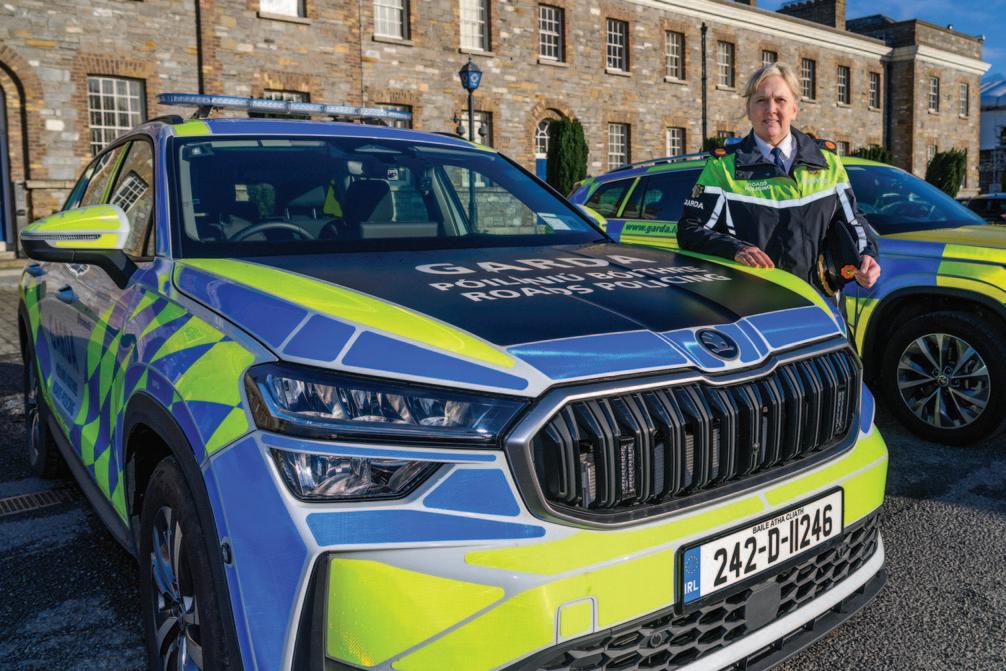
Tasked an overarching objective of reduced road deaths – as per Our Journey Towards Vision Zero, the Government’s road safety strategy – An Garda Síochána is implementing a blend of enhanced technology, visibility, and education initiatives, alongside traditional enforcement.
“In working to reduce the frequency of death and serious injury on our roads, the application of a criminal justice approach alone will not deliver the intended outcome,” Hilman asserts.
“While An Garda Síochána must play its part in terms of enforcement activity, equally we must work with local authorities and other stakeholders to construct safer roads by design, utilise technologies such as new speed cameras, and deliver education initiatives if the State is to reduce the number of deaths and serious injuries on our roads.”
Within the technology sphere, the deployment of new equipment has already had a significant role to play.
“Over the last 12 months, we have rolled out a substantial amount of new equipment in relation to roads policing,” the Assistant Commissioner observes.
This includes investment in new handheld speed detection devices, drug detection devices, automatic number
plate recognition (ANPR) technology, and new high-performance vehicles, unmarked motorcycles, and an unmarked heavy goods vehicle (HGV).
Utilised as part of Operation Iompar, An Garda Síochána has deployed its unmarked HGV to target distracted driving through targeted enforcement on the dual-carriageway and motorway network throughout the State.
Simultaneously, drawing insights from data relating to fatal and serious injury collisions as well as speed data, nine static cameras will come into effect in locations determined to be high risk. Funded from An Garda Síochána’s budget and costing around €2.4 million over 18 months. To date three of these have gone live on the N59 Galway; N17 Mayo; and N13 Donegal. While work is continuing on static cameras at the following six sites:
• N80, Carlow;
• N25, Kilkenny;
• N22, Cork;
• N69, Limerick;
• Dolphins Barn, Dublin; and
• R772, Wexford.
Meanwhile, in 2024, three additional average speed cameras also went operational at:
1. the N3 (Butler’s Bridge);
2. the N5 (Swinford); and 3. the N2 (Slane).
Furthermore, Garda Commissioner Drew Harris has tasked Hilman with developing a business case for the introduction of an additional 100 static speed cameras.
“The international evidence relating to speed safety cameras demonstrates a positive correlation in changing driver behaviour and reducing speed. Given that speed is a determining factor in the severity of many collisions and is the single greatest contributor – at 30 per cent – to fatal collisions, the lower speeds people drive at, the lower the number of road deaths,” the Assistant Commissioner insists.
In April 2024, Garda Commissioner Drew Harris instructed all uniformed gardaí to undertake a mandatory 30 minutes of road safety policing on each shift. Commenting on this initiative, Hilman acknowledges: “While we knew that many gardaí were already doing this, the initiative has instilled a more coherent focus. While it is not necessarily about enforcement, it is about being visible.”
However, visibility, she says, is not solely reliant on “being seen in our new fleet of garda liveried vehicles”, it also means visibility via social media platforms and education programmes.
“Talking about these initiatives and giving them visibility in the media, alongside our high engagement rate on social media ensures that the public know and understand that these capabilities are being deployed,” the Assistant Commissioner remarks.
Education and personal responsibility is paramount to roads policing and one such initiative highlighting this is the Lifesaver Project. Delivered by gardaí in collaboration with the Road Safety Authority (RSA) and primarily aimed at the transition year and leaving certificate cohorts, the road safety education programme is “hard hitting and realistic” and aims to highlight “the devastating effects that road traffic collisions have on people’s lives”.
Trialled in Limerick over several years before rolling out nationally, now more than 200 gardaí are trained to deliver a consistent and coherent two-hour programme of interactive engagement.
Discussing the cross-border aspect of roads policing, Hilman notes north-south collaboration has “a twin aspect”. Firstly, collaboration occurs geographically along the border where operations may be undertaken concurrently. “These operations are designed and led by the local divisions in the border region, north and south,” she says.
Secondly, at Garda Headquarters level, there are regular meetings with counterparts in the PSNI. “The Chief Superintendent from the Garda National Roads Policing Bureau regularly meets with the equivalent Chief Superintendent from the PSNI. One tangible outworking of this collaboration materialised in November 2023, when – for the first time – a National Slow Down Day was implemented across the entire island,” the Assistant Commissioner recalls.
Similarly, when An Garda Síochána introduced a new roadside drug driving testing system (Drugwipe 6s) in December 2022, this was then followed by the PSNI which introduced the system on an initial 12-month pilot basis from September 2024.
“Given the volume of border crossings each day, partnership working with the
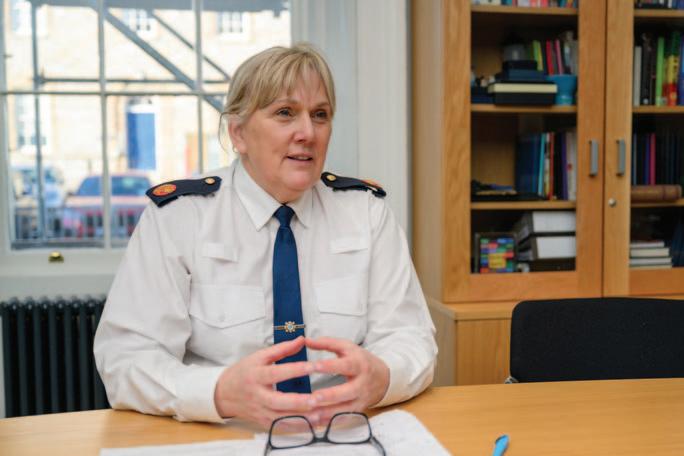
“In working to reduce the frequency of death and serious injury on our roads, the application of a criminal justice approach alone will not deliver the intended outcome.”
PSNI is ongoing. The PSNI speak with us about our experiences and vice versa. It is very much about sharing experiences, including around campaigns that are being launched,” Hilman explains.
Having just completed the phase one action plan (2021-2024) of Our Journey Towards Vision Zero, the Government’s road safety strategy, attention has now turned to the phase two action plan (2025-2027).
“The Department of Transport and the RSA are engaging with us and other partners in terms of phase two, building on our achievements to date,” the Assistant Commissioner says.
Summarising her vision for roads policing, the Assistant Commissioner wants to consolidate the work completed in 2024 regarding the roll out of new equipment and notes the high volume of candidates in the recent recruitment competition for roads policing.
“In the immediate term, our focus is on increasing the skills capacity in roads policing, while continuing to enhance the equipment and training available to our
members. In the long term, as the Government has outlined, we want to achieve Vision Zero. This means halving road traffic deaths and serious injuries by 2030 and eradicating them altogether by 2050. We cannot lose sight of that vision,” she emphasises.
Allied to this is the maintenance of An Garda Síochána’s roads policing capacity and capability. This includes the wellbeing of Garda members, many of whom are exposed to the scenes of fatal road traffic collisions.
“That is something we are cognisant of, and we have robust occupational health processes in place, but we must recognise that while our members have a job to do, they are also human beings. By looking after the wellbeing of gardaí, we enable them to keep communities safe.
“Similarly, I regularly meet with the representative groups which support families whose loved ones have been killed or seriously injured in a road traffic collision. As such, when discussing the figures relating to road deaths, I am always very conscious that behind each number is a loved one.”

The new Policing, Security and Community Safety (PSCS) Act 2024 provides for the continuation of GSOC as Fiosrú – Oifig an Ombudsman Póilíneachta (Office of the Police Ombudsman), changing its governance model from a three-person Commission to a single Ombudsman, with a structure that includes for the first time a Chief Executive Officer, enhancing Fiosrú’s powers and independence.
Key statutory objectives of Fiosrú include:
a) to promote public confidence in the processes for resolving complaints made by members of the public and in investigations;
b) to improve public understanding of role and functions of the Police Ombudsman;
c) to ensure that her functions are performed in a timely, efficient and effective manner and in accordance with fair procedures; and
d) to undertake research and analysis –in order to identify trends and patterns in complaints and investigations.
In preparation for the imminent commencement of the legislation in 2025, the work of GSOC staff gathered pace throughout 2024. This included:
• On 9 July 2024, following an open competition and approval by resolutions of both Houses of the Oireachtas, Emily Logan was formally appointed by President Michael D Higgins on commencement of the PSCS Act. As Police Ombudsman, she will be independent, accounting directly to the Oireachtas for her statutory functions.
• On 9 September 2024, GSOC welcomed the appointment of Sheila McClelland as its first Chief Executive-designate for Fiosrú, the Office of the Police Ombudsman. Fiosrú will have its own vote and McClelland will be the Accounting Officer, accountable to the Oireachtas through the Committee of Public Accounts.
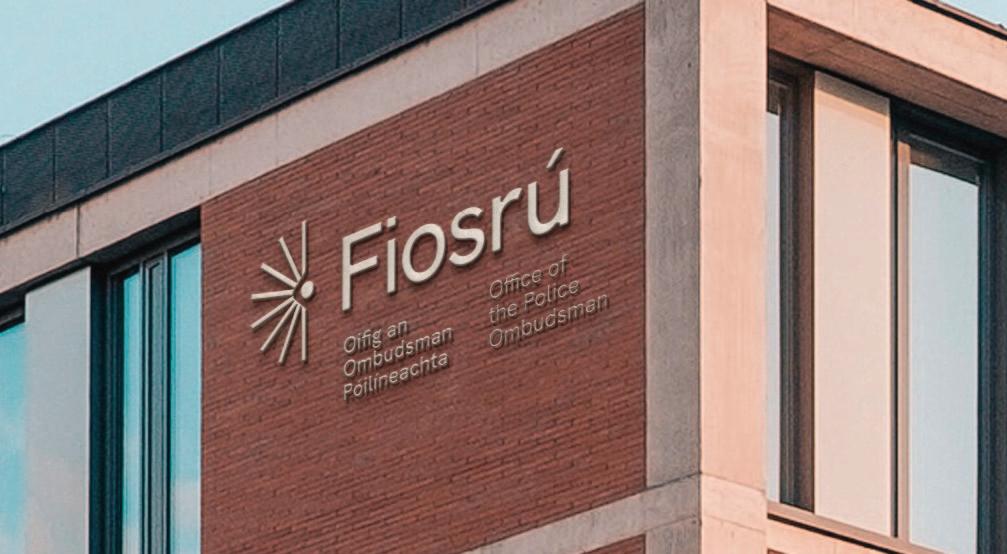
• Working with colleagues across the justice system to review and reform our processes based on new provisions in the PSCS Act 2024. This includes the Department of Justice, An Garda Síochána, and our sister organisations: the Policing Authority and the Garda Inspectorate.
• Investing in our staff through a bespoke, post graduate, Law Enforcement Oversight Accreditation Programme at the University of Limerick on 28 January 2025, with 54 of our staff participating.
• Establishing new units; for instance, the development of a digital investigation unit, a specialist services unit and a statutory review unit to respond to the changing nature of policing itself, the operating environment and our oversight obligations.
• We will launch our new website for members of the public following the commencement of the Act.
• We are undertaking a significant project to develop a new case management system – a fundamental piece of infrastructure for performance, research and public accountability of Fiosrú.
We look to the future with optimism as we embark on a new journey of policing oversight.
• Fiosrú Process Reform project, to establish, in bilateral meetings with An Garda Síochána, the reformed systems, procedures, protocols and agreed lines of communication necessary for effective inter-agency cooperation in the delivery of the new legislations statutory functions.
We have been working on this transition from GSOC to Fiosrú since July 2021 so we are keenly awaiting the commencement date of Fiosrú. We look to the future with optimism as we embark on a new journey of policing oversight. At the forefront of all the work undertaken by GSOC and to follow, Fiosrú, is that we are equipped to provide the service that the public
expects: efficient, effective, human rights based policing oversight that promotes accountability and enhances trust in ourselves as the largest oversight body in Ireland, in line with the vision outlined by the Commission on the Future of Policing. Commencement of the Policing, Security and Community, Safety Act 2024 is expected in March 2025.
E: info@gsoc.ie
W: www.gardaombudsman.ie
X: @gardaombudsman.ie

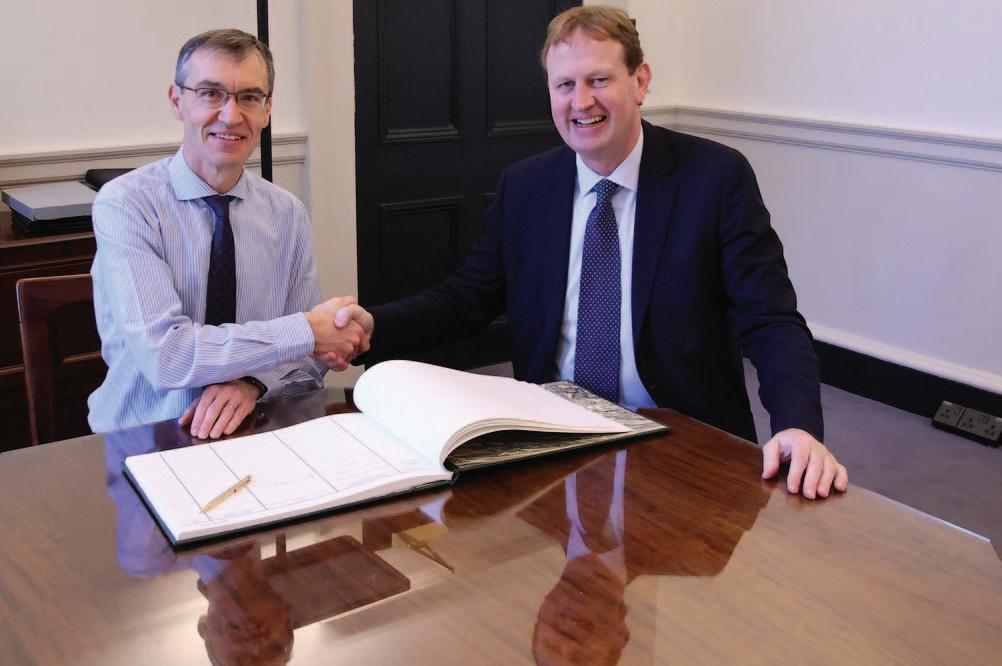
After a mixed record on meeting policing targets in the 2020 Programme for Government (PfG), the 2025 PfG contains less specific targets from government for policing improvement, with enhancing digital skills a key priority alongside increasing the number of Garda staff and officers.
A key commitment in the 2025 PfG is the expansion of the numbers of staff and officers at An Garda Síochána. The PfG outlines a commitment to “provide funding to recruit at least 5,000 new Garda recruits and additional Garda staff over the next five years”. These efforts are to be supported by additional funding for Garda training colleges and incentives to encourage retention.
The PfG also promises increased investment in equipment and technology, with a focus on digital policing capabilities. New mobile units and an expanded fleet are planned, alongside enhanced access to body-worn cameras and modern forensic tools. A new

National Policing Technology Fund will be established to support the rollout of real-time crime monitoring and predictive policing analytics.
Addressing organised crime remains a priority in the new PfG. The 2025 PfG pledges continued funding for the Garda National Drugs and Organised Crime Bureau, with increased cross-border cooperation to disrupt criminal networks. The Government aims to introduce legislative reforms aimed at expanding asset seizure powers under the Criminal Assets Bureau (CAB), allowing for quicker intervention against suspected organised crime operations.
The PfG outlines plans for a renewed focus on community policing, aiming to strengthen ties between gardaí and local communities. The Government aims to introduce a Community Safety Partnership Model, aimed at promoting collaboration between gardaí, local authorities, and social services to prevent crime at the local level.
There is also a commitment to increasing the number of gardaí stationed in rural areas, reversing previous trends of centralisation in large settlements. New rural policing units will be established aiming to improve response times and deter crime in isolated communities.
The Government aims to modernise policing structures through administrative and legislative reforms.
A review of the Garda Síochána Act is set to take place, with a focus on streamlining oversight mechanisms and improving Garda accountability.
The establishment of an independent policing standards commission is proposed to monitor performance and address complaints more efficiently.
The PfG also commits to a review of sentencing guidelines for serious crimes, aiming to ensure consistency and proportionality in judicial decisions. Reforms will include expanded judicial training in areas such as domestic violence and coercive control.
In the context of the growing threat of cybercrime, the 2025 PfG includes a pledge to establish a National Cyber Crime Unit, expanding on the existing Garda Cyber Crime Bureau. If established, the unit will aim to focus on combating online fraud, data breaches, and child exploitation, with new legislation to strengthen digital forensics capabilities.
Online safety is also addressed, with the introduction of tougher penalties for cyber harassment and an expansion of digital literacy programs to educate young people about online risks.
The focus on increasing Garda numbers, enhancing crime prevention tools, and tightening legal frameworks reflects a government intent on addressing growing public concerns around crime and safety.
While community policing remains an important aspect, the broad strategic approach reflects a move to the right on justice and policing towards a tougher stance on crime, reinforced by digital and legislative enhancements. However, as shown by the previous government’s mixed record on implementing policing policy, the effectiveness of these measures will ultimately depend on successful implementation and sustained funding commitments.


Technology investment Expand use of body cams and digital tools
Community policing Expand community policing initiatives
Organised crime Enhance powers of Criminal Assets Bureau (CAB)
Rural policing Increase rural Garda presence
Cybercrime Strengthen Garda National Cyber Crime Bureau

Partially met: Garda numbers rose but target not fully achieved
Provide funding to recruit at least 5,000 new Garda recruits and additional Garda staff over the next five years
Met: Body cameras piloted and some digital policing measures implemented
Partially met: Some pilot schemes introduced but not fully implemented
Met: Legislative updates improved asset seizure capabilities
Not met: No significant increase in rural station openings
Partially met: Bureau expanded but lacked dedicated funding
Establish a National Policing Technology Fund
Introduce a Community Safety Partnership Model
Increase CAB powers for asset seizure
Create new rural policing units
Increase funding for a Garda National Cyber Crime Bureau
One of the least surprising appointments to the new government was that of Fianna Fáil’s Dublin Bay South TD and former barrister Jim O’Callaghan, to lead the Department of Justice.
O’Callaghan turned down a junior ministerial role when the 2020 coalition was negotiated, and this appointment is his first at cabinet level, having been on the backbenches since 2016.
While the Programme for Government sets the broad legislative agenda for the new minister, O’Callaghan has set out his stall by initiating a review of the legal framework surrounding sexual offenses committed by minors, citing the need for a comprehensive approach to tackling youth crime.
Since taking office, O’Callaghan has spoken on several key policing challenges. In response to recent incidents in Dublin, he commended gardaí for their swift response and reaffirmed the Government’s commitment to public safety.
He has also indicated support for the establishment of a dedicated transport policing unit with arrest powers, aimed at addressing antisocial behaviour on public transport.


In May 2024 An Garda Síochána launched the first of three phased introductions of body worn cameras (BWCs) at five Garda stations nationwide.
An amendment to existing legislation will be required to provide the basis for processing digital video evidence at the scale required for the full national rollout of BWCs. Preparing for this, An Garda Síochána looks ahead to the next phase of the project, to procure and implement a national Digital Evidence Management system followed by a tender for a national roll-out of Body Worn Cameras. In anticipation of this, those using the cameras explain the benefits of the technology and how they are finding it a useful and valued tool.
The proof of concept is now running in Store Street, Kevin Street and Pearse Street Stations in the Dublin Metropolitan Region; Henry Street in
Limerick City; and Waterford Garda Station. Each division has been issued a different camera type along with an accompanying digital evidence management system.
The proof of concept was designed to understand the technical aspects of each camera and backend digital evidence system, how BWCs will be used operationally in addition to the training, Code of Practice, the digital evidence journey and governance in use of the camera in everyday policing.
When complete, the three-phased pilot will inform a procurement process for the introduction of body worn cameras in Garda Stations nationwide.


Since the first of these three phased introductions commenced in Dublin on 31 May 2024, 750 trained gardaí have been trialling their use in a variety of policing settings.
According to users, they are proving their worth with a wide range of benefits being experienced. As well as capturing important evidence, the cameras are showing themselves to be a valuable tool in keeping the public safe, and are now considered a vital part of the Garda’s personal protective equipment.
In Limerick City, gardaí attached to Henry Street Garda Station are using Reveal cameras - these are the only camera in the proof of concept to have a video screen on the face of them.
When activated this displays what the cameras is capturing in front of them when recording. The effect of this means when the Garda turns on the camera, the person they are engaging with can see themselves displayed on screen.
As noted by Chief Superintendent Derek Smart of the Limerick Garda Division this, coupled with the warning that
recording is in progress, has resulted in the quick de-escalation of incidents.
“What is different to how we operated before is that now we have a witness with us. So when I go out on the beat now I go and get the camera. It contributes to our safety one hundred percent. What we tend to find is things deescalate quickly and in situations where I feel there is a risk to the public or myself I can put it on, and it is there as a witness.”
A very useful feature of all the cameras is they have a 30 second buffer. This means once recording begins the footage captures the previous 30 seconds.
Chief Superintendent Smart says: “As you are interacting with someone, aggression can start from the beginning, you might try yourself to de-escalate and if that doesn’t work you can turn it on and then it captures what happened previously and you then have a record of the whole interaction”.
Of course, this is not always going to be the outcome and there will be some
individuals who continue to flout the law irrespective of the presence of the BWC.
This was the experience of Garda Emily Maher, a member of the Community Policing Unit in Henry Street, when on August 15 2024 – just two weeks into the proof of concept – she encountered an unruly man while on duty in Limerick city.
“Just two weeks after the launch here in Limerick, I was on Thomas Street, a highly populated area in Limerick city during the day with a Garda Trainee. We were just talking with a member of the public, when a male came up to us. He was highly abusive with us from the getgo. We had had no interaction with him prior to this, he just approached us and began calling us every name under the sun. I then asked him to leave the area a lot of times, as there were so many people around,” Garda Maher says.
When she tried to de-escalate the situation, Garda Maher felt the man was posing a risk, so she informed him she was going to turn on the camera.

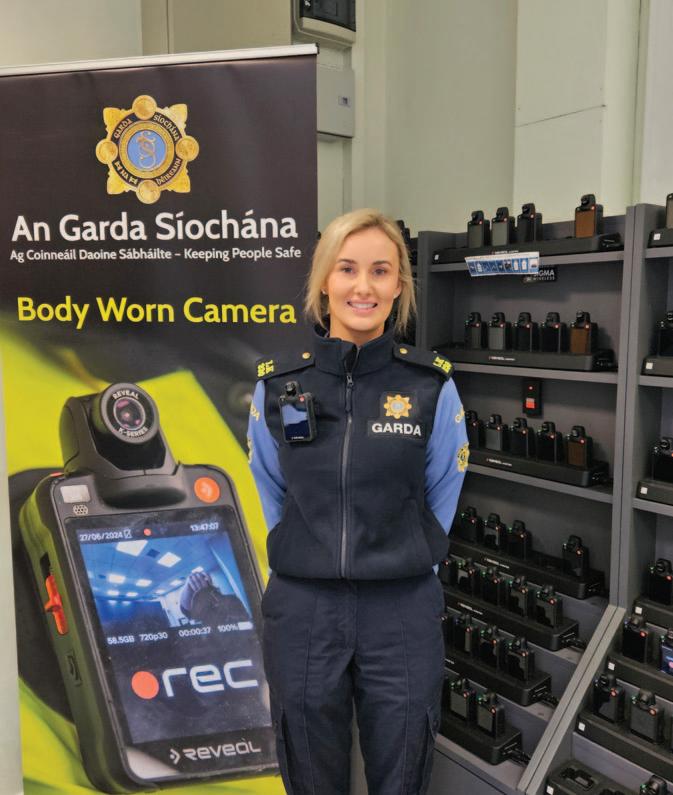
“He did not seem to mind, and he was asked to leave but he would not. Then I went to leave with the Garda trainee and he actually followed us and began walking in front of us. I felt that was intimidating and a lot of the public had stopped and were looking. He continued to be abusive. I had turned the camera on because there was a risk to safety, either to ourselves or the public on the street,” she says.
When the man continued to ignore the direction to leave the area and continued to be abusive, Garda Maher made the decision to arrest him, and called for additional units to help. He was arrested and appeared in court the following day. The body worn camera footage formed part of the evidence against him, and resulted in a guilty plea and a sentence of three months being imposed. The defendant filed an appeal but when it came to the appeal court he learned the footage would be brought as evidence, and withdrew the appeal.
This was the first conviction in Limerick involving BWC footage.
Each recorded piece of footage is categorised by members as evidential or non-evidential. In the Reveal cameras this can be done on the camera itself, which reduces workload, another bonus. The footage is saved for 31 days if deemed non-evidential but retained for longer depending on the evidential category used by the member.
It is important to note that despite over 4,000 recordings being deemed as evidential – which means they contain footage in support of a crime having occurred – An Garda Síochána has to date, not been required to show this footage in court.
Initial feedback indicates that the existence of the footage in cases pursued by An Garda Síochána is resulting in admissions of guilt, thereby negating the need to prove the case in court.
“In every case where we have had with the footage available the defendants involved have pleaded guilty. We have briefed all the solicitors and judges here in Limerick and we will be briefing the Law Society soon. We are not getting any negative feedback. Some have raised a concern around facial recognition but this is not something that is used with the BWCs,” Chief Superintendent Smart says.
Asked if they were to go back to a position where they were to be without the cameras, Chief Superintendent Smart says: “It is certainly part of our PPE now, and that’s one of the reasons why I would not like to give it up. It is also fantastic to capture a scene when we arrive. In incidents of child neglect for instance, it allows for a good visual on how a situation looks when we arrive. This serves to support the interventions required in those instances.”
Meanwhile in Waterford Garda Station, where Motorola Solutions Body Worn Cameras are part of the PoC, gardaí attached to plain clothes detective duties are also trailing BWCs. Here, Detective Inspector Donall Donoghue says they are so effective that he cannot see a situation where his team would be without them.
“At the beginning the uptake was somewhat slow, but now we are way more confident in using them, and I know our team would not go back.
“It has really helped in respect of drugs searches we conduct. We can see very clearly why we were suspicious in the lead up to a search. The camera captures the search, and what is found or not found. The 30 second buffer also often captures evidence of items being discarded ahead of a search of a person or car, which is another support to us in proving cases,” Detective Inspector Donoghue says.
Ahead of a national rollout, the Detective Inspector had these words of advice for gardaí who have yet to use BWCs.
“What I would say to those using it, is trust it and believe in it, treat it like your notebook because it is recording incidents as you come upon them. There’s nothing like it in terms of capturing a scene. Our personnel go out wearing it every day, and have found it a positive initiative. I know our team would not go back,” he says.


A number of key benefits have been seen in Waterford.
“Before we search a car we can turn it on, and it captures what we have found or not found as the case may be. It has worked to calm situations, when we arrive at something – be it a search or another engagement. The one thing I would say about the camera we are using is that the footage and the sound is very clear, it’s excellent really,” Detective Inspector Donoghue concludes.
In the Dublin Metropolitan Region Inspector Máiréad Scanlon said they have found BWCs to be effective in dealing with public disorder incidents where it serves to counteract false complaints and helps de-escalate situations.
“We had an incident of public disorder within the DMR where one of the antagonisers jumped onto a Garda car and acted as if he was after being knocked down. The cameras were activated and the 30 second buffer captured the incident as it unfolded, showing his actions,” she says.
This individual then became aggressive with Gardaí and took the keys of their car and threw them away.
“The cameras caught the entire thinghow it unfolded, how volatile it was and how it ignited so quickly. In looking back
on the footage what we also found was how much it really highlighted how professional the Gardaí were in that type of situation,” Inspector Scanlon says.
An Garda Síochána is learning from the experience of those participating in the proof of concept, and this feedback is feeding into refinements of the systems and processes being used.
The use of BWCs is covered in the Garda Síochána (Recording Devices) Act 2023, which was signed into law in December 2023, and the Garda Síochána (Recording Devices) Act 2023 (Code of Practice) Order 2024.
For more information, please visit: W: www.garda.ie/en/body-worncameras


The 10th annual Housing Ireland conference will host a range of expert domestic and international speakers who will comprehensively explore the challenges, and tangible opportunities for Ireland’s housing practitioners as they seek to deliver 303,000 new homes by 2030.
Expert speaker panel includes:




James Browne TD Minister for Housing, Local Government and Heritage
Graham Doyle, Secretary General, Department of Housing, Local Government and Heritage
David Silke, Director of Insights and Operations, The Housing Agency
Caroline Timmons
Assistant Secretary, Affordable Housing Department of Housing, Local Government and Heritage



John Coleman Chief Executive, LDA
Fidelma McManus
Partner and Head of Housing, Beauchamps
Paul Hogan, Acting Assistant Secretary, Planning Department of Housing, Local Government and Heritage

Margaret Geraghty
Assistant Programme Coordinator, Housing Delivery Coordination Office Team Local Government Management Agency

Paul Benson, Acting Assistant Secretary, Social Housing Delivery Department of Housing, Local Government and Heritage



Éadaoin Ní Chléirigh Director of Development Operations, Irish Council for Social Housing
Dan Hill, Director Melbourne School of Design and Professor of the Built Environment University of Melbourne
Killian O’Sullivan
Assistant Planner, Fingal County Council





John O’Connor Former Chair, The Housing Commission
Michelle Norris, School of Social Policy, Social Work and Social Justice University College Dublin
Kathryn Meghen CEO, Royal Institute of the Architects of Ireland
Orla McGuirk, Director Construction Advisory KPMG Ireland and Society of Chartered Surveyors Ireland
Roslyn Molloy, Head of Policy, Practice, and Communications The Housing Agency